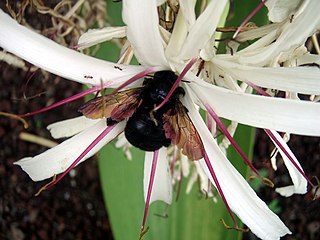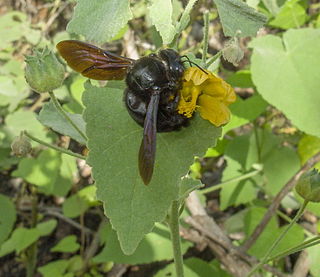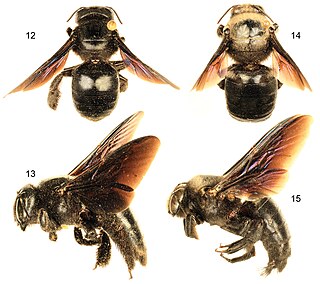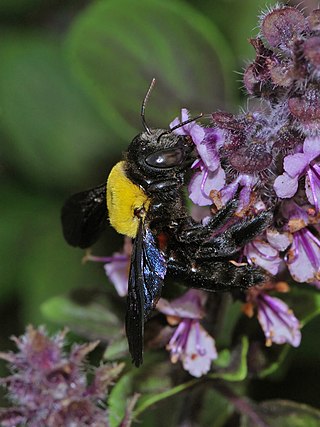
Megachile rotundata, the alfalfa leafcutting bee, is a European bee that has been introduced to various regions around the world. As a solitary bee species, it does not build colonies or store honey, but is a very efficient pollinator of alfalfa, carrots, other vegetables, and some fruits. Because of this, farmers often use M. rotundata as a pollination aid by distributing M. rotundata prepupae around their crops. Each female constructs and provisions her own nest, which is built in old trees or log tunnels. Being a leafcutter bee, these nests are lined with cut leaves. These bees feed on pollen and nectar and display sexual dimorphism. This species has been known to bite and sting, but it poses no overall danger unless it is threatened or harmed, and its sting has been described as half as painful as a honey bee's.

Carpenter bees are species in the genus Xylocopa of the subfamily Xylocopinae. The genus includes some 500 bees in 31 subgenera. The common name "carpenter bee" derives from their nesting behavior; nearly all species burrow into hard plant material such as dead wood or bamboo. The main exceptions are species in the subgenus Proxylocopa, which dig nesting tunnels in suitable soil.

Mason bee is a name now commonly used for species of bees in the genus Osmia, of the family Megachilidae. Mason bees are named for their habit of using mud or other "masonry" products in constructing their nests, which are made in naturally occurring gaps such as between cracks in stones or other small dark cavities. When available, some species preferentially use hollow stems or holes in wood made by wood-boring insects.

Melastoma affine, also known by the common names blue tongue or native lassiandra, is a shrub of the family Melastomataceae. Distributed in tropical and sub-tropical forests of India, South-east Asia and Australia, it is a plant of rainforest margins. Bees are the principal pollinators of this species.

Xylocopa virginica, sometimes referred to as the eastern carpenter bee, extends through the eastern United States and into Canada. They are sympatric with Xylocopa micans in much of southeastern United States. They nest in various types of wood and eat pollen and nectar. In X. virginica, dominant females do not focus solely on egg-laying, as in other bee species considered to have "queens". Instead, dominant X. virginica females are responsible for a full gamut of activities including reproduction, foraging, and nest construction, whereas subordinate bees may engage in little activity outside of guarding the nest.

Xylocopa violacea, the violet carpenter bee, is the common European species of carpenter bee, and one of the largest bees in Europe. It is also native to Asia.

Australian native bees are a group of bees that play a crucial role in the pollination of native plants. There are over 1,700 species of native bees in Australia, ranging from small solitary bees to the social stingless bees. Native bees are important for native ecosystems, providing pollination services to native plants, and hold value for Australian agriculture.

Hylaeus alcyoneus, commonly known as the banksia bee, is a bee species endemic to Australia where it is commonly found in the coastal heaths of eastern and southern Western Australia. This bee is an important pollinator of Banksia species.

Xylocopa sonorina, the valley carpenter bee or Hawaiian carpenter bee, is a species of carpenter bee found from western Texas to northern California, and the eastern Pacific islands. Females are black while males are golden-brown with green eyes.

Amegilla cingulata is a species of blue-banded bee native to Australia. Currently, several scientific organizations are conducting research on how A. cingulata benefits agriculture through its distinctive "buzz pollination".

Xylocopa aerata, the golden-green carpenter bee or green carpenter bee, is one of two species of carpenter bee found only in the conservation areas around Sydney, and in the Great Dividing Range in New South Wales in Australia. Its only other habitat as of 2020 is on Kangaroo Island in South Australia. The species is especially vulnerable to fire, and much of its habitat was burnt during the 2019-2020 bushfire season in Australia.

The California carpenter bee, Xylocopa californica, is a species of carpenter bee in the order Hymenoptera, and it is native to western North America.

Xylocopa latipes, the broad-handed carpenter bee, is a species of carpenter bee widely dispersed throughout Southeast Asia. This bee inhabits forests and constructs nests by burrowing into wood. It often makes long deep tunnels in wooden rafters, fallen trees, telephone poles, etc., but is not found in living trees.

Dufour's gland is an abdominal gland of certain insects, part of the anatomy of the ovipositor or sting apparatus in female members of Apocrita. The diversification of Hymenoptera took place in the Cretaceous and the gland may have developed at about this time as it is present in all three groups of Apocrita, the wasps, bees and ants.

The Oriental carpenter bee, Xylocopa nasalis, or Xylocopa (Biluna) nasalis, is a species of carpenter bee. It is widely distributed in Southeast Asian countries. It is a major pollinator within its ecosystem, and is often mistaken for a bumblebee. The species leads a solitary lifestyle with a highly female-biased colony in the nest.

Xylocopa darwini, the Galápagos carpenter bee, is the only native species of bee in the Galápagos Islands, to which it is endemic. Altogether, only three species of bee are found in the islands. This species found on 75% of the largest islands. It is sexually dimorphic and is known for its complex behavior. As the only native bee, Xylocopa darwini serves as an important primary pollinator within the plant-pollinator network of the archipelago.

Xylocopa sulcatipes is a large Arabian carpenter bee. These multivoltine bees take part in social nesting and cooperative nesting. They are metasocial carpenter bees that nest in thin dead branches. One or more cooperating females build many brood cells. They have been extensively studied in Saudi Arabia and Israel.

Xylocopa pubescens is a species of large carpenter bee. Females form nests by excavation with their mandibles, often in dead or soft wood. X. pubescens is commonly found in areas extending from India to Northeast and West Africa. It must reside in these warm climates because it requires a minimum ambient temperature of 18 °C (64 °F) in order to forage.

Xylocopa micans, also known as the southern carpenter bee, is a species of bee within Xylocopa, the genus of carpenter bees. The southern carpenter bee can be found mainly in the coastal and gulf regions of the southeastern United States, as well as Mexico and Guatemala. Like all Xylocopa bees, X. micans bees excavate nests in woody plant material. However, unlike its sympatric species Xylocopa virginica, X. micans has not been found to construct nest galleries in structural timbers of building, making it less of an economic nuisance to humans. Carpenter bees have a wide range of mating strategies between different species. The southern carpenter bee exhibits a polymorphic mating strategy, with its preferred method of mating changing as the season progresses from early spring to mid summer. Like most bees in its genus, the southern carpenter bee is considered a solitary bee because it does not live in colonies.

The tiger bee fly, Xenox tigrinus, is an insect of the family Bombyliidae found in the eastern United States and southern Ontario. It formerly went by the name Anthrax tigrinus. The distinctive wing pattern may resemble tiger stripes, giving the tiger bee fly its name. Like other members of the bee fly family, the tiger bee fly parasitizes the larvae of other insects.




















